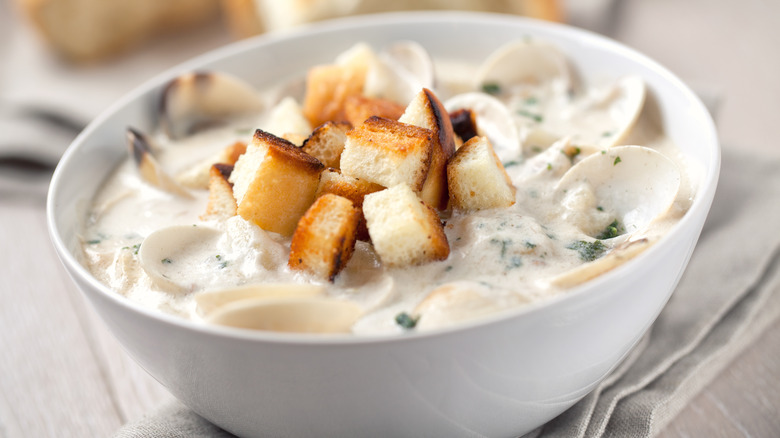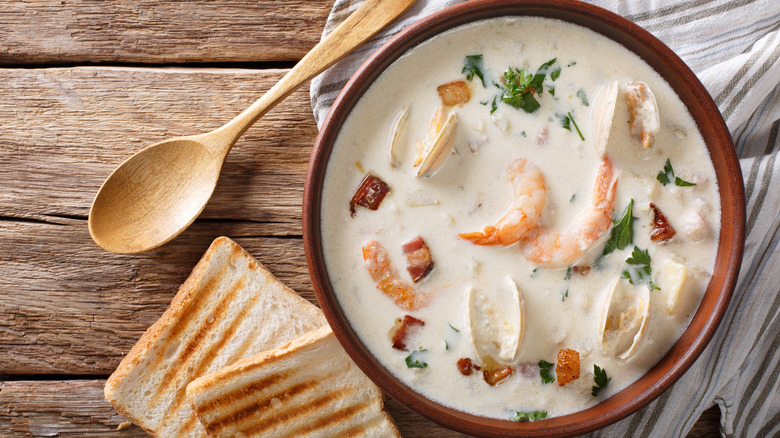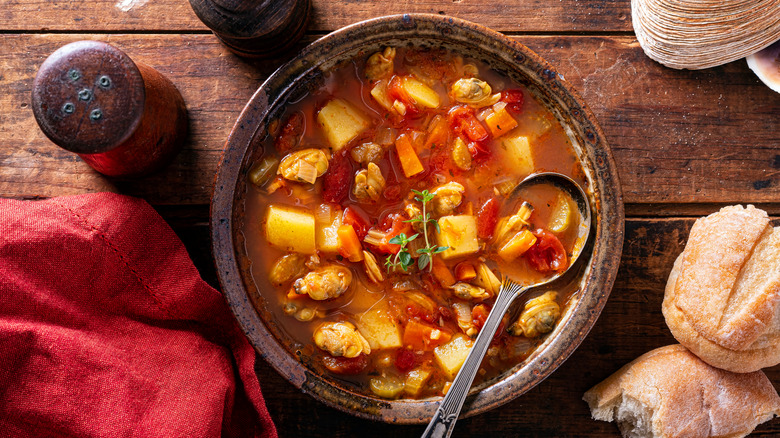The Difference Between Manhattan And New England Clam Chowder
One could argue there's no better meal on a damp, cold day than clam chowder. It's hearty, flavorful, and steamy –- exactly the kind of comfort food to chase the chill away. Our adoration for it is deep. It has inspired cartoons, festivals, and a national holiday (February 25). But that's where people cease seeing eye to eye — because clam chowder can be a contentious topic.
There are two popular and distinct versions of clam chowder: New England and Manhattan. The opposing and defining characteristic is whether the base is made with cream or tomatoes. Some contend it's not chowder if it doesn't have that luscious and heavy creamed stock that corn, mushroom, and chicken chowder also share in common. Merriam-Webster defines it as "a soup or stew of seafood (as clams or fish) usually made with milk or tomatoes, salt pork, onions, and other vegetables." (via Eater). And while Taste of Home claims chowder almost always features a creamy base for the chunky vegetables and protein, they acquiesce only in the case of the Manhattan kind. For those who can't choose, there are recipes for New Manhattan and Long Island Chowder, which combine cream and tomatoes. Either way, we suggest adding oyster crackers or pan-fried croutons.
Let us share more about them in the hopes of persuading anyone adamantly on one side. But more importantly, let us break bread (or crush crackers) over a bowl of the good stuff.
New England clam chowder
According to The New York Times, New England clam chowder was a meal concocted in the 1600s by Breton seafarers sailing to New England and eastern Canada's islands. The prevalence of cream in French foods made it a natural addition to this hearty onboard stew. The publication further explains the word chowder comes from the French cauldron, "chaudiere." Yet, heed the cautionary tale told by this Simpsons episode, and don't pronounce it like that. The ending — er or ah — is up for debate, but the hard "ch" is not really a choice. The dish has a few deviations, too; salt pork, onion, celery, potatoes, clams, and cream or milk thickened with a roux form the crux of the magic that is classic New England clam chowder.
Per Taste of Home, it must be "thick and rich" for it to be considered something more than soup; just how thick is another matter not always agreed upon. Wallpaper paste, bisque, or somewhere between the two, everyone has a preference. A contest-winning recipe contains the usual, but also garlic, chicken bouillon, and dried thyme; this one stirs the flour directly into the half-and-half. Although we have no evidence for this, chowder tastes best in those special bowls. Some swear by a dash of hot sauce, and of course, you can't go wrong with a stash of crackers or garlicky croutons.
Manhattan clam chowder
It's been called "horrendous" by renowned chef James Beard (via What's Cooking America), and while we can think of a plethora of dishes that deserve that characterization, Manhattan clam chowder isn't one of them. A warming broth fortified with aromatic vegetables, garlic, and savory bits of bacon and clam, this rendition of clam chowder is loved by many. Yet, who are we to argue with a legend of gastronomy? Even author Eleanor Early said, "it is only a vegetable soup" and that tomatoes and clams were completely incompatible (via The New York Times).
Some reports say Rhode Island cooks were the first to put tomatoes in their chowder, while others believe the practice started on Coney Island. Further, The New York Times details a letter by a Brooklynite who took the credit. Regardless of where it originated, it was to the utter chagrin of the people of Maine and Massachusetts. (Believe it or not, in 1939, a Maine politician tried to make it illegal to add tomatoes to chowder.) In the end, New Yorkers (the outsiders) were blamed, and Manhattan clam chowder endured.
In addition to the tomatoes or tomato paste which contribute to its red color, Manhattan clam chowder also typically includes onion, garlic, celery, carrots, and potatoes in a relatively thin broth per Eater. It is fresher and brighter than its counterpart while being more vegetable-heavy. In Big Apple fashion, you might add a little bite with white wine and hot chili flakes.


